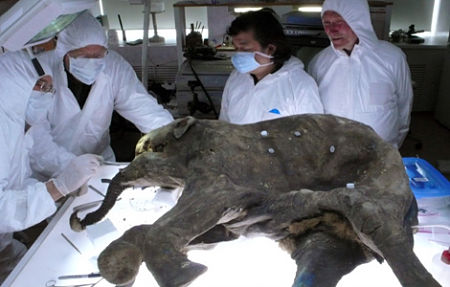Icy Mammoth Inspires Heartwarming Documentary

Scientists recently uncovered Lyuba, a one-month-old mammoth from about
40,000 years ago, perfectly preserved in ice. Lyuba was the subject of the new
National Geographic documentary, "Waking the Baby Mammoth."
The unpredictable discovery of Lyuba, a perfectly preserved, one-month-old woolly mammoth, in the 21st century is a telling tale no doubt - and the National Geographic's reputation for outstanding cinematography and thorough information does not fall short in this documentary. Translating to "love" in Russian, Lyuba's name is very well the theme of the documentary, as a deep sympathy for the baby mammoth buds inside each viewer through revelations of her youthful age and the tragic story of her death.
From the time Lyuba is discovered in the permafrost of the Siberian Arctic to her meticulous transfers to scientific labs in Russia and Tokyo, the dramatic footage of the infant mammoth and the puzzle pieces of her journey tug at the heartstrings of each and every closet woolly-mammoth lover. It also doesn't hurt that the animations of baby Lyuba are unbelievably convincing, from her lifelike interactions with her mother and other characters in the documentary to the way her long nose flows up into the air and back down again with such ease.
It's no surprise that Lyuba's discovery is a paleontologist's dream. Not only is the woolly mammoth an extinct species from nearly 40,000 years ago but, until little Lyuba, no discovery of the species had been so well-preserved and in tact. While a group of paleontologists worked on the baby calf to discover as much about the extinct species as possible, each was more enthusiastic than the other. Tissues were taken out for analysis, teeth were scanned to determine Lyuba's age and I swear I saw the equivalent of a paleontologist's O-face when they discovered the remains of the mother's milk, the first human access to mammoth milk in history.
Though these revelations are remarkable, the reactions they create will never be as awe-inspiring to those who don't really know what an "infrared spectrometric analysis" is. In other words, to the average viewer, they're not what make the story. Lyuba is.
What Lyuba did for the scientific world is incredible, allowing scientists from all over the world to discover new things about an already-extinct species. But what Lyuba did for the rest of us is even more incredible. The documentary's strong suit is not so much in the details of the discovery but, more so, in its production of a phenomenal tale of a little baby mammoth that preserved through tens of thousands of years only to make a home in the hearts of viewers. To most, she's Lyuba. But to a select others, she might as well be the little mammoth that could.



